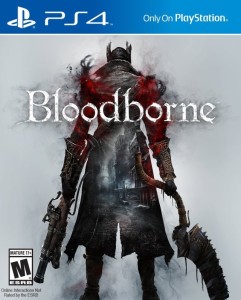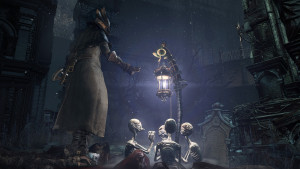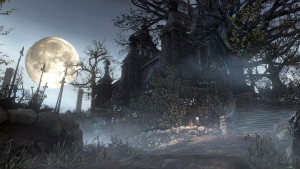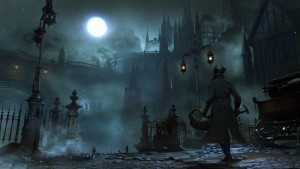After the release of a very derivative sequel to From Software’s and Hidetaka Miyazaki’s Dark Souls, there came early press releases of a new successor. This one would be a Sony exclusive, Demons Souls 2 in all but name, and right from the first images it was clear the series was taking a new direction. The stagnant nature of Dark Souls 2, which Miyazaki did not work on in full capacity, no doubt informed the drastic changes seen to the formula in his newest effort, Bloodborne. The lessons to be learned from a game that did not have its own identity, from a game that tried to capture as many outside successes as possible into an amalgam, was to generate as distinct a flavor as possible for the next game. The result was not produced without its sacrifices, but they were all for the greater good of the most refined experience to be had on the PlayStation 4 to date. Bloodborne, more than most games, knows precisely what it wants to be and how it will proffer itself to the player when adversity after adversity is thrown down the pike.
Bloodborne is a dense package in almost every aspect of its design, with visuals being the best example. The opening locale of Yharnam is crammed to bursting with detail and overwrought Gothic style structures. The atmosphere is conveyed well in this way, as the entire city appears as an oppressive maze of stonework. Indeed one of the more potent enemies in the game is the environment, and Yharnam proves at every turn to be an intimidating one. As the game slowly introduces story concepts of sanity and makes repeated references to an “Eldritch Truth”, the architectural design of Yharnam begins to echo those themes. Every building, from a small personal residence to one of the dozens of towering cathedrals is replete with spires, fluted stonework, stained glass windows, vaulted ceilings, and all crammed into such proximity that many of these rich details are obscured by yet more rich detail. Yharnam is the architectural equivalent of a long word missing all of its vowels, just a string of hard sounds given no room to breathe. This reviewer could sometimes not suss out the admirable qualities of this design from the absolute lunacy of it, but was more than apt to forgive any personal annoyance at specific instances in favor of the bigger picture. The city’s cramped, albeit highly detailed, structure calls upon visions of a living sewer, the kind that once helped spread plagues across Europe. And true to the game’s name, there is indeed a plague to be spread here.
Whereas previous Miyazaki games themed themselves around Souls, collecting them or defending against them, Bloodborne takes a more steampunk and scientific approach by being themed around blood and the vague process of ministration. Whatever it entails, either simple blood letting or transfusing, the process is widely popular among Yharnamites (an admittedly laughable genitive), and would seem responsible in part for the predicament at large. To wit, upon the player’s arrival the city is under lock down in observance of something called The Hunt. During this time, society seems to wick out the worst and sickest of its kind, those deranged by some compelling lunar force not unlike old werewolf tales, while the sane shut themselves up in incensed houses for the night. The player takes the unwitting role of a Hunter, charged with culling the monsters that now roam the streets and either abetting or avoiding other troubled Hunters. From there, the story takes many turns and fanciful twists that are best pieced together firsthand. Suffice it to write only that Miyazaki’s games are not ones to enlighten players more than they are to charge them with figuring out a narrative puzzle. What might be considered obtuse for lack of competency tends usually to seat itself on the better part of intrigue. Finding the missing pieces to this puzzle outside the game in online communities can be fun should the curiosity strike.
In practice, the game operates much like its predecessors which should come as little surprise. An offhand and a mainhand weapon are employed, as before, except this time around there exist no shields to reasonably protect from attacks. In an attempt to keep the pace of the game much faster and much more skill based than in previous entries, Miyazaki has ditched the defensive options afforded in the other games for one reliant on dodging. With the removal of weight limits, and indeed of traditional dodge-rolling, the character is made much more nimble at all times. Stamina, the governing stat that allows everything from attacking to running and “quickstepping”, has been made more plentiful in response to this greater demand of the resource. With no true way to deflect blows, players must focus on reading enemy attacks and knowing when and where to quickstep to avoid a swift demise. The previous Souls games could be played in such a manner and, despite my own attestations about giving players more choices in how to tackle these challenges by either being offensive or defensive, it is clear that Bloodborne was never meant to play host to such options. The proper way to encounter a foe is either learned or it is not learned, there is a very limited capacity to muddle through the mechanics newly added to this game.
Chief among those new mechanics is the addition of a firearm. Initially it seems an empowering item until upon closer examination it proves a slow and weak tool for directly applying damage. Like as with parrying with a shield in the previous three games by pressing L2 at the moment an enemy strikes, firing a shot to interupt an attack will lead to a staggered foe and an attack of opportunity. Then pressing R1 directly in front of the target will produce a “Visceral Attack” not unlike the Ripostes of the earlier games. The risk and reward for executing this maneuver are ramped up as bullets are in limited supply, guns are generally slow to fire, and defensive capacities of characters are more limited overall. Armor sets found or purchased throughout the game no longer include a range of light to heavy options, but a general selection of longcoats and robes that offer varying degrees of physical and elemental damage reduction. Players should not expect to be one-shot by opponents, but neither should they too often plan on being struck by any attack. However, another new mechanic does exist that helps to reward the more aggressive play style fostered by all of these changes, and that is the Regain system. Upon losing some health from any source, be it an enemy attack or simply fall damage, striking a foe will replenish some of that lost health up to a certain point. The stronger the attack, the more health is regained. This opens the game up to allow some trading of blows between opponents instead of continued sidestepping, although boldness is only rewarded so much. The game still asks a measure of calmness of the player, as well as some light inventory management. The primary method for healing is now Blood Vials, consumables dropped by some enemies that can be held to a maximum of twenty after which the remainder are held in a hubworld storage chest inside the Hunter’s Dream.
The Hunter’s Dream makes up one of the other two major gameplay aspects of Bloodborne, and that is the return to a hubworld design as it was in Demon’s Souls. Unconnected extant worlds are accessed via tombstone-like alters that place the player at the analogue to a Bonfire in past games, the Lamp Post. Lamp Posts function little more than respawn points and warp points as all inventory and leveling duties must be carried out in the hubworld. Insight, roughly similar to Humanity in games past, is used to buy special items and summon or invade other players in online modes and is gained by defeating or encountering bosses. Further lending itself to the psychological horror roots of the plot, Insight is also tied to a debuff called Frenzy that attacks the mind by overwhelming it about Truths apparently lethal to learn. The higher a player’s carried Insight, the more susceptible they are to this particular attack, which exists as a masterful example of blending in story with gameplay in meaningful ways.
And finally there exist the Trick Weapons, Bloodborne‘s greatest front facing change to gameplay. These are otherwise normal melee weapons, many with exact copied movesets from the previous games, but with the ability to transform into alternate versions. In essence, every weapon is two weapons, which usually involve a weaker long-reaching form and a stronger short range form. Switching between both forms during combat to take advantage of each forms’ strengths is a rewarding mechanic that encourages deep familiarization with a specific weapon. Unlike in the past where weapons might be ditched in favor of a newer better one, there are no real similarities between weapons in Bloodborne as each is worthy in its own right despite the overall stable of weapons being smaller this time around. Learning and focusing on using just one or two weapons is the ideal strategy, especially given the very limited number of upgrade catalysts used to improve their stats, and goes hand in hand with the more refined and narrow focus of the game. Weapons can be upgraded with several found items, some of which can be freely slotted and unslotted at will to boost specific parameters, and this holds true for the firearms as well. Some diversification is possible when choosing character stats to level, either Strength or Arcane or Skill, and these proficiencies can impact which weapons can be wielded, but the general play strategy is the same throughout. Close confrontations, a heavy emphasis on reading the opponent and knowing when to move in for a kill, are required of all players as there exist no ranged or tank options.
To round out the offer, Bloodborne also includes the ancillary Chalice Dungeons. These randomized dungeons offer extended replayability beyond the usual New Game + option, and pit the player against foes in constantly changing environments. They seek to emulate that first-time experience where nothing is yet memorized, enemy placements are not expected, and environmental hazards must be cautiously surveyed. But in the end it is just an emulation of that experience as the randomized nature of these dungeons mean the level design is not up to par with the normal content, the visual appeal is that of a generic dank dungeon and all of the rich lore is missing from the experience. The rewards for participating in these challenges are similarly sub-par, often just crafting ingredients used in generating more challenging Chalice Dungeons. Better variants of pre-existing weapons do await in the deeper depths of the dungeons, as to unique enemies and bosses, but they will not come until many repeated encounters and dull rewards later. Their inclusion does not hurt what is otherwise on offer, they are thankfully a completely optional affair, and stand almost to highlight the difference between the tightly designed nature of Bloodborne-proper and a more generic offering.
But as with anything, there are some grey skies to be found. Load times are arduous in some instances, especially given the game’s difficulty. It can be a common occurrence to return to and lose to a difficult boss encounter in less time than it takes for the system to load back into the game world upon death. At about forty-five seconds, not including the “You Died” screensplash, players are left staring at a Bloodborne logo for nearly a minute in most instances of failure. Assurances of a future patch to aid in these load times eliminates any fanciful ideas that this was an intentional punishment and not systemic of the game’s design or the hardware to which it is tied. The fidelity of the game is also a fair target of criticism, as the graphical leap over previous games is marginal at most. With some very pronounced framerate and pop-in issues, especially if the player is adept at running through large areas of the game, make the game look like a technical early-generation title. After over two years of the console being on the market, a PlayStation 4 exclusive should not be protected by such umbrellas as “early gen” or “launch title” any longer. As well, online connectivity can be spotty and online interactions sparse even now in the height of its popularity. While not an online-centric game, issues with Bloodborne servers can potentially result in small amounts of lost progress as a drop-out means being booted back to the main menu. As a final gentle jab, as all of these complaints have been thus far quite minor, the difficulty tends to waffle about with some later boss encounters being forgettably easy while others are entirely ruthless. There seems to be little reason for it behind the inherent difficulty in designing a satisfying boss encounter, which is a shame given the consistently masterful quality of the rest of the game.
To say the difficulty of this game has been increased over previous entries in the loosely connected series is a bit less accurate than to say the difficulty has been changed. What is asked of the player is not always more but is instead a very different thing entirely. In place of a methodical high-fantasy “sword and board” affair, there now exists an action oriented steampunk game that tests reflexes a bit more than preparatory skill. Doubtless many of these curve balls were thrown to shake up the long-time Souls fan, but the boldness of them should not go understated. In the rising popularity of the series, as with many other popular series, the fanbase began attaching itself to memes and smugly self-referential aspects that Dark Souls 2 was all too willing to oblige. Bloodborne wipes the chaff off of the table to get back to what matters, and it is ultimately the cornerstone of its success as a game. It set a goal and a purpose for the kind of game it was to be, without taking notes from previous sessions of creativity or from the uncritical demands of fandom, and set pen to paper on fulfilling a vision. This is precisely the kind of game that can be produced by a vision, by a true creative talent, and not one to be emulated by selecting popular mechanics. The result is a game that respects the player with a proper blend of using what has worked in the past with foundationally new additions. It is a more intelligent product for it, and thus demands that it be consumed intelligently.




